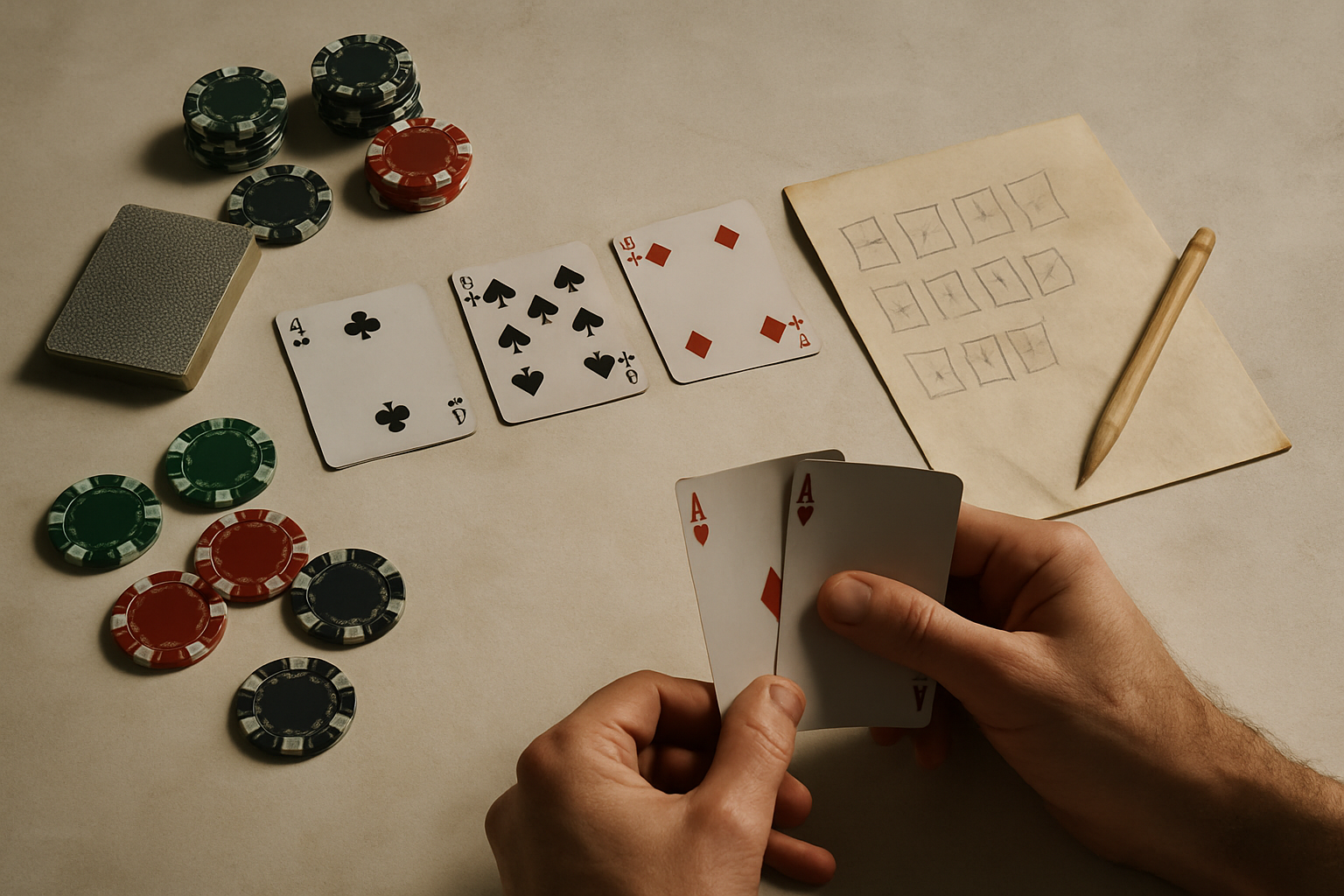Entering the world of multi-table poker tournaments can be exhilarating yet daunting. As a seasoned player, I’ve navigated the virtual felts, honing strategies that have led to success in online poker arenas.
In this article, I’ll share insights on mastering the art of multi-table poker strategy, equipping you with the tools needed to thrive in competitive online tournaments. From understanding position play to exploiting opponents’ tendencies, the key to triumph lies in a blend of skill, patience, and adaptability.
As I delve into the intricacies of multi-table poker, I’ll unravel the tactics that can elevate your game and propel you towards victory. Whether you’re a novice looking to improve or a seasoned player aiming to sharpen your edge, mastering multi-table poker strategy is essential for conquering the virtual poker landscape.
Join me on this journey as we delve into the dynamic world of multi-table poker strategy, unraveling the secrets to achieving success in online tournaments.
Understanding Multi-Table Poker Strategy
Exploring multi-table poker strategy is crucial for success in online tournaments. Recognizing the dynamics of playing across multiple tables can significantly impact your gameplay. Position play is fundamental in multi-table poker.
It’s essential to grasp the significance of position and how it influences your decisions. Positional awareness allows me to make strategic moves based on my seating in relation to the dealer button.
Adapting to opponents’ strategies is key in multi-table poker. Understanding opponents’ tendencies gives me an edge in predicting their moves. By analyzing their playing styles, I adjust my approach to maximize opportunities and exploit their weaknesses.
Balancing aggression and caution is vital. I strike a balance between aggressive plays to accumulate chips and cautious moves to safeguard my stack. This strategic mix keeps opponents guessing and maintains my competitive advantage in the tournament.
Incorporating these elements into my multi-table poker strategy has been instrumental in my success. Mastering these aspects enhances gameplay and increases the chances of achieving victory in online poker tournaments.
Developing a Winning Mindset
In preparing for online tournaments, mental readiness is as crucial as mastering the gameplay tactics. Here are key aspects to consider:
Mental Preparation for Online Tournaments
I focus on cultivating a strong mental outlook before diving into online poker tournaments. It’s essential to stay composed and resilient in the face of challenges, allowing me to make sound decisions under pressure.
Handling Variance and Bad Beats
When confronted with unfavorable outcomes, I remind myself that variance is an inherent part of the game. By accepting bad beats as temporary setbacks, I maintain a stable mindset and avoid tilt, ensuring consistent performance.
Mastering Pre-Flop Play
Exploring the intricacies of pre-flop play is crucial in multi-table poker tournaments. Understanding how to navigate this initial stage sets the foundation for success throughout the game.
I’ll dive into the key strategies that can help you make informed decisions before the flop is even dealt.
- Positional Advantage: As I’ve experienced firsthand, your position at the table significantly influences your pre-flop strategy. Being in a late position gives you more information about your opponents’ intentions, allowing for more aggressive plays with a wider range of starting hands. On the contrary, playing from an early position requires a tighter selection of hands to avoid risky situations.
- Hand Selection: Selecting the right hands to play pre-flop is a skill that separates amateurs from seasoned players. While premium hands like pocket pairs and high-value face cards are desirable, understanding when to fold marginal hands is equally important. I’ve found that discipline in hand selection can prevent unnecessary losses and preserve your chip stack for strategic moves later in the game.
- Sizing Your Bets: Another critical aspect of pre-flop play is determining the optimal bet sizes based on your hand strength and position. Adjusting your raises according to the stage of the tournament and your opponents’ tendencies can help you extract maximum value from strong hands while bluffing effectively with weaker holdings. Finding the right balance in bet sizing is essential for maintaining control and keeping your opponents guessing.
Mastering pre-flop play requires a combination of strategic thinking, adaptability, and situational awareness. By honing your skills in hand selection, understanding positional dynamics, and refining your betting strategies, you can gain a competitive edge in multi-table poker tournaments right from the start.
Adapting to Different Stages of a Tournament
Exploring the diverse phases of a poker tournament is fundamental to optimizing strategies and maximizing success potential. I’ll delve into the distinct characteristics of each stage and provide insights on how to adapt your gameplay accordingly.
Early Stage
In the initial phase of a tournament, it’s crucial to adopt a conservative approach to preserve your chip stack while assessing your opponents’ tendencies. Focus on playing premium hands and avoid taking unnecessary risks.
By observing the table dynamics and identifying the playing styles of your opponents, you can lay the groundwork for strategic moves in the later stages.
Middle Stage
As the tournament progresses into the middle stage, the blinds increase, putting pressure on players’ stacks. It’s essential to loosen up your starting hand requirements slightly and introduce more aggressive plays to accumulate chips.
Look for opportunities to exploit tighter opponents and utilize your stack size to leverage favorable situations. Maintaining a balanced strategy between aggression and caution is key to navigating this crucial phase successfully.
Late Stage
In the late stage of a tournament, with the blinds at their highest levels, the game intensifies, and strategic decisions become paramount. At this point, consider your position relative to the table and the remaining players carefully.
Utilize your accumulated chips to put pressure on shorter stacks and avoid getting blinded out. Strategic aggression coupled with timely bluffs can help cement your position as you approach the final table.
Final Table
Reaching the final table is an accomplishment in itself, requiring a mix of skill and strategy to outlast your opponents. Adapt your gameplay based on the remaining chip stacks and utilize your understanding of opponents’ tendencies to seize opportunities.
Balance calculated risks with prudent decision-making to chip up and position yourself for a shot at the top prize. Stay focused, maintain composure, and capitalize on your hard-earned place among the finalists.
Navigating through the varying stages of a poker tournament demands adaptability, strategic acumen, and a keen awareness of changing dynamics. By adjusting your gameplay to suit each phase, you can enhance your chances of success and make informed decisions to secure a competitive edge.
Utilizing Bluffing and Reading Opponents
Bluffing and reading opponents are essential skills in multi-table poker tournaments. In these high-stakes events, mastering the art of bluffing and accurately assessing your opponents’ behaviors can give you a significant advantage at the virtual tables.
Let’s dive into how strategic bluffing and effective opponent reading can help you succeed in online tournaments.
Implementing Strategic Bluffs
When it comes to bluffing in online poker tournaments, it’s crucial to do so selectively and with purpose. Bluffing too frequently can lead to being easily exploited by observant opponents. By strategically incorporating bluffs into your gameplay, you can keep your opponents guessing and increase your chances of winning pots without the strongest hands.
Reading Opponents’ Patterns
Analyzing your opponents’ betting patterns, tendencies, and overall gameplay can provide valuable insights that you can leverage to make informed decisions. Pay attention to how they bet, raise, or fold in different situations.
Look for clues that reveal the strength of their hands or potential bluffs. By understanding your opponents’ patterns, you can adjust your own strategies to exploit their weaknesses and maximize your winnings.
Putting It All Together
Bluffing and reading opponents go hand in hand in the dynamic landscape of multi-table poker tournaments. By mastering these skills, you can outmaneuver your competition and increase your chances of finishing on top.
Remember, successful bluffing requires careful calculation and observation, while reading opponents accurately demands constant attention and adaptability. In the fast-paced world of online poker, honing your bluffing techniques and sharpening your opponent-reading abilities can set you apart as a formidable player.
By incorporating these strategies into your gameplay, you’ll be well-equipped to navigate the complexities of multi-table tournaments and emerge victorious against a diverse field of competitors.





